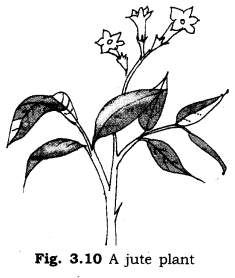EVENTS CONVENT HIGH SCHOOL
05/01/2022 CLASS- 6 SESSION 2021-22
SUBJECT :SCIENCE
CHAPTER-3
FIBER TO FABRIC
______________________________________
Q.1. Classify the following fibres as natural or synthetic: nylon, wool, cotton, silk, polyester, jute.
Ans. Natural fibres: wool, cotton, jute, silk.
Synthetic fibres: nylon, polyester.
Q.2. State whether the following statements are ‘true’ or false’:
(a) Yam is made from fibres.
(b) Spinning is a process of making fibres.
(c) Jute is the outer covering of coconut.
(d) The process of removing seeds from cotton is called ginning.
(d) Weaving of yam makes a piece of fabric.
(e) Silk fibre is obtained from the stem of a plant.
(g) Polyester is a natural fibre.
Ans.
(a) True
(b) False
(c) False
(d) True
(e) True
(f) False
(g) False
Q.3. Fill in the blanks:
(a) Plant fibres are obtained from____________ and___________ .
(b) Animal fibres are___________ and___________ .
Ans.
(a) cotton plants, jute plants
(b) wool, silk
VERY SHORT ANSWER TYPE QUESTIONS
Q.1. Name two varieties of cloth materials which are commonly used.
Ans. Cotton, silk/wool.
Q.2. What are fabrics?
Ans. Fabrics mean a woven material, textile or other materials resembling woven cloth.
Q.3. Name some fabrics in your surroundings.
Ans. Bed-sheets, blankets, curtains, table clothes, towels and dusters.
Q. 4. Name the thing which is used to make fabric.
Ans. Yarns.
Q.5. What are yarns made of?
Ans. Yarns are made up of thin strands called fibres.
Q.6. How many types of fibres are there? ,
Ans. There are two types of fibres:
(i) Natural fibres
(ii) Synthetic fibres
SHORT ANSWER TYPE QUESTIONS
Q.1. What do you observe when you are visiting a nearby tailoring shop?
Ans. In a tailoring shop we observe that there are many cuttings of fabrics left over after stitching. We see that some cuttings are of cotton, some are of silk or wool and some are of synthetic fibres.
Q.2. List the steps involved in the preparation of fabric.
Ans. The following steps are involved in the preparation of fabrics:
(i) Obtaining fibre,
(ii) Preparation of yarn from fibres by spinning,
(iii) When two sets of yarn are involved, yarns are woven on looms to make a fabric. When a single yam is used, the fabric is prepared by knitting.
Q.3. What are natural fibres? Explain with examples.
Ans. The fibres obtained from plants and animals are called natural fibres. For example, cotton from cotton bolls, jute from jute plant, silk from cocoon of silkworm and wool from hair of animals like sheep or goat.
Q.4. What are synthetic fibres?
Ans. The fibres which are made from chemical substances or which are not obtained from the plant and animal sources are called synthetic fibres. For example, polyester, nylon, and acrylic, etc.
Q.5. Explain how jute is obtained from the jute plant.
Ans. The jute plant is normally harvested at flowering stage. The stems of harvested plants are bundled and immersed in water for 10 to 15 days. The stems rot (the process is called retting) and fibres are separated by hand. These fibres are converted into yarns to make fabrics (Fig. 3.10).
Q. 6. What are looms?
Ans. The devices on which weaving of fabrics takes place are called looms. The looms are either hand operated or power operated.
LONG ANSWER TYPE QUESTIONS
Q.1. Describe the process of the formation of yam from cotton wool.
Ans. The cotton wool is obtained from cotton plants. The cotton plants are grown in fields. They are usually grown at the places having black soil and warm climate. The fmits of the cotton plants called cotton bolls are about the size of lemons. After maturing, the bolls burst open and seeds covered with cotton fibres can b,e seen. From the cotton bolls cotton is picked by hands. Fibres are then separated from the seeds by combing. This process is called ginning of cotton. It is done by hand or by machines. These fibres are then converted into yam.
Q.2. Describe the process of spinning and weaving.
Ans. Spinning: The process of making yarn from fibres is called spinning. In this process fibres from a mass of cotton wool are drawn out and twisted. By this fibres come together to form a yarn. Spinning can be done by hand, by takli and charkha. On a large scale, spinning is done with the help of machines.
Weaving: The process of arranging two sets of yarns together t6 make a fabric is called weaving. The process of weaving can be done on looms. The looms are either-hand operated or power operated.

